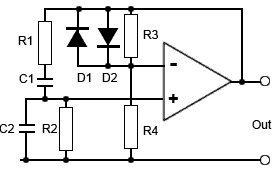chopcooey
Newbie level 4
hello there, i am currently making an analog function generator for a project; i know my design could be improved, but i have a problem from which i have no idea the source is.
Basically, i am using an op amp(opa602) wien bridge oscillator to generate sine waves, and varying frequency with a potentiometer. At this point i have no problem, im obtaining clean sine waves at up to higher than 1.5 MHz, as long as my closed loop gain of 3 is well adjusted.
Then, im using the sine wave output to drive a comparator(tried with and without hysteresis) circuit (with op amp lm7171), and i generate decent square waves of the same frequencies. But my problem is that, when i plug the output of the sinewave wien oscillator to the comparator, my sine wave becomes more and more distorted as frequency increases.
I could probably use an extra switch to stop powering the comparator for when i want a sine wave but that's not really what i wanna do. I could probably also make a square wave oscillator seperatly instead, but i would rather have my frequency control in just one spot. Has anyone any idea as to what creates that distortion and how to deal with it?
Basically, i am using an op amp(opa602) wien bridge oscillator to generate sine waves, and varying frequency with a potentiometer. At this point i have no problem, im obtaining clean sine waves at up to higher than 1.5 MHz, as long as my closed loop gain of 3 is well adjusted.
Then, im using the sine wave output to drive a comparator(tried with and without hysteresis) circuit (with op amp lm7171), and i generate decent square waves of the same frequencies. But my problem is that, when i plug the output of the sinewave wien oscillator to the comparator, my sine wave becomes more and more distorted as frequency increases.
I could probably use an extra switch to stop powering the comparator for when i want a sine wave but that's not really what i wanna do. I could probably also make a square wave oscillator seperatly instead, but i would rather have my frequency control in just one spot. Has anyone any idea as to what creates that distortion and how to deal with it?

